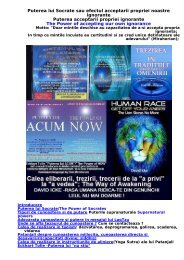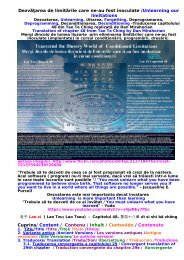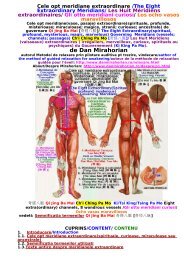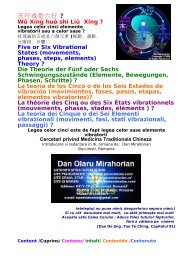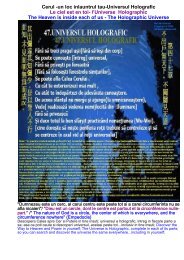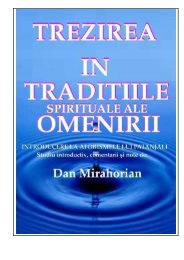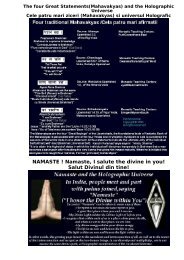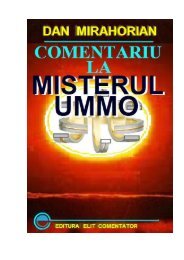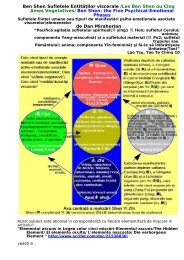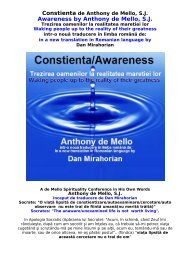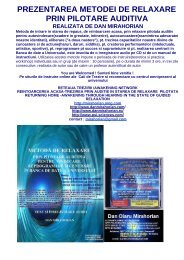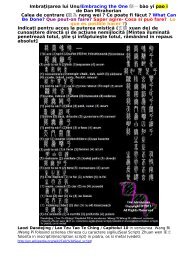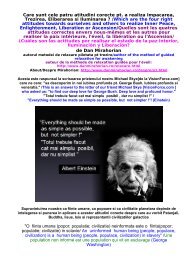Centre energetice subtile in diferite traditii spirituale de ... - Mirahorian
Centre energetice subtile in diferite traditii spirituale de ... - Mirahorian
Centre energetice subtile in diferite traditii spirituale de ... - Mirahorian
You also want an ePaper? Increase the reach of your titles
YUMPU automatically turns print PDFs into web optimized ePapers that Google loves.
Indian spirituality is other-worldly, the goal be<strong>in</strong>g the atta<strong>in</strong>ment of a state of eternal<br />
existence beyond the cosmos - nirvana or moksha (liberation). The Indian i<strong>de</strong>al is the<br />
renunciate sage - the sadhu or sanyas<strong>in</strong> - who gives up the world for a life as a<br />
homeless yogi and holy-man, <strong>de</strong>pen<strong>de</strong>nt on the offer<strong>in</strong>gs of others for sustanance.<br />
Hence Indian Tantra is orientated to atta<strong>in</strong><strong>in</strong>g a transcen<strong>de</strong>nt state of Liberation.<br />
Ch<strong>in</strong>ese culture and spirituality is generally this-worldly. The i<strong>de</strong>al sage is the<br />
Confucian "gentleman" or "superior man", who knows the best way to respond to<br />
family, social, or political situations. And although there is a quietist element to the<br />
Ch<strong>in</strong>ese soul (just as there is an extrovertive one to the Indian) one f<strong>in</strong>ds that even<br />
Ch<strong>in</strong>ese meditation is this-worldly: the cultivation of the vital-force for health and<br />
longevity for example (Tai-Chi-Chuan), the search for alchemical immortality, or<br />
attun<strong>in</strong>g oneself to the currents or flow of the cosmos (which is the true purpose of the<br />
martial arts).<br />
Thus, whereas the Indian and Tibetan yogis cultivated the knowledge and<br />
manipulation of the subtle body for the purpose of atta<strong>in</strong><strong>in</strong>g a transcen<strong>de</strong>nt state of<br />
liberation, the Ch<strong>in</strong>ese sages - the practioners of the Taoist "<strong>in</strong>ner alchemy" - did so for<br />
the purpose of rejuvenation and spiritual immortality. It may well be that "all roads<br />
lead to Rome" <strong>in</strong> the end, but the do so from very different directions.<br />
Thus <strong>in</strong> addition to this purely mystical, reclusive Taoism of the Tao-te-Ch<strong>in</strong>g the one<br />
hand, and to village shamanism and magic on the other, there was a third<br />
metaphysical, occult tradition <strong>in</strong> Ch<strong>in</strong>a that has also been given the term "Taoism".<br />
This is a tradition of yogic transformation of the vital-force; the so-called "<strong>in</strong>ner<br />
alchemy", because it uses alchemical metaphors and purports to be a quest for<br />
immortality. It is this esoteric Taoism which constitutes the native Ch<strong>in</strong>ese<br />
counterpart to Indian and Tibetan Tantra.<br />
The basic premise of these esotericist and occultist Taoists is that man has only a<br />
limited store of vital-force (ch'i). This leaks away through day-to-day activities, and<br />
when it's all gone, that's it, the person's <strong>de</strong>ad. But it is possible to make the ch'i go<br />
back <strong>in</strong>si<strong>de</strong>, rather than outwards, and then up the sp<strong>in</strong>e to the crown. This obviously<br />
is very like the Tantric Kundal<strong>in</strong>i. In ascend<strong>in</strong>g, the ch'i progresses through various<br />
stations, which are given exotic names like the Elixar-field, the Yellow Hall, the<br />
Heaven. These are clearly similiar to the chakras. Now comes the difference with<br />
Shakta-tantra. Reach<strong>in</strong>g the top of the head, the ch'i then <strong>de</strong>scends down the front of<br />
the body, down to the navel, and then around aga<strong>in</strong>, form<strong>in</strong>g a complete circuit. This<br />
circuit is known as "The Circulation of the Light", or "The Microcosmic Orbit". Through<br />
rhythmic breath<strong>in</strong>g and visualisation, the Taoist yogi can circulate the ch'i, harmonise<br />
the polarities of Y<strong>in</strong> and Yang, atta<strong>in</strong> cosmic consciousness, become an immortal, and<br />
return to the Tao<br />
Although there is no actual one on one correspon<strong>de</strong>nce to the chakras of Tantra<br />
(unless one consi<strong>de</strong>r the lower, middle, and higher tan tiens or alchemical cauldrens,<br />
which one can equate approximately with the navel, the heart, and the brow chakras),<br />
the path that the chi takes along the ma<strong>in</strong> acupunture meridians as directed dur<strong>in</strong>g<br />
the Microcosmic Orbit does correspond <strong>in</strong> part to the chakras of Theosophy and the<br />
New Age movement and as <strong>de</strong>scribed by Barbara Brennan - <strong>in</strong> other words the<br />
"secondary" rather than the "primary" chakras. The follow<strong>in</strong>g two diagrams from the<br />
L<strong>in</strong>g-shu, an ancient Ch<strong>in</strong>ese medical text, <strong>de</strong>scribes the grand circulation or<br />
microcosmic orbit.<br />
The <strong>de</strong>scend<strong>in</strong>g or <strong>in</strong>voluntary circulation runs along the conception vessel meridian<br />
from the lower lip, through the chest abdomen to the tip of the sp<strong>in</strong>e.<br />
The ris<strong>in</strong>g or controlled circulation runs along the governor vessel from the tip of the<br />
sp<strong>in</strong>e up the sp<strong>in</strong>e and over the top of the head to the upper lip.<br />
Grafic from Lu K'uan Yü, Taoist Yoga - Alchemy and Immortality, Ri<strong>de</strong>r and Company,<br />
London, 1970, p.13; Images from David V. Tansley, Subtle Body - Essence and<br />
Shadow, (1977, Art and Imag<strong>in</strong>ation Series, Thames and Hudson, London)<br />
This same technique has been taught <strong>in</strong> a very clear manner by Mantak Chia, who,<br />
however, reduces the number of concentration po<strong>in</strong>ts from those <strong>in</strong> the above diagram<br />
to a number more equivalent with the conventional mo<strong>de</strong>l of chakras.<br />
[from: http://www.kheper.net/topics/chakras/chakras-Taoist.htm]<br />
The Crystal Palace (Upper Tan Tien; Mud ball)



